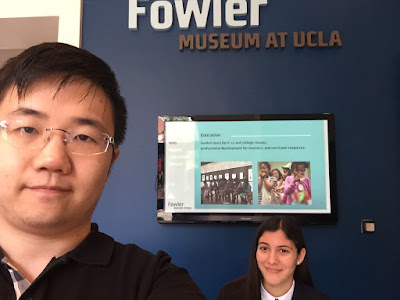Biotech plus Art, Biotechnology and our living
Human being's technology has been developing since the Stone Age. However, for thousands of years, we only achieved technological advancements that have an impact on non-life objects and materials. Only until recent decades, we human beings started to have some real control over living creatures and genes within, including ourselves.
Biotech has been a very hot topic or theme in arts as introduced by Professor in this week's lecture and materials. And we have seen many Artistic expressions combined with living animals or at the cell and even gene level. This includes interesting projects from the fluorescent rabbit to putting the image of milky way into DNA in a mouse's ear.
However, there is a reason why biotech has been a such popular topic in art expressions. The reason is that finally, our technology is so advanced that we can control or change something (gene) within a living creature, even including our selves, and many applications regarding the gene and biotech technology ring a bell to human beings' ethics.
From cloning a sheep to modifying the gene of a baby-to-be-born in laboratories to reduce his risk of getting serious diseases, we have gone too far in the application of biological and gene technology. Are these applications and experiments ethical? Will they jeopardize our health and safety in the future eventually? Do we have the right to use, modify a living creature such as a rabbit as the object of our experiment? Is it inhumane to the animals?

Dolly, the first cloned sheep (right)(2)
I believe these applications are inhumane but all these questions have been raised as introduced in the materials.
These questions are too distant to discuss. However, our biotech advancements have also greatly influenced our way of eating. Some aspects of our food production have also become unhealthy and inhumane.
I have watched the interview with Michael Pollan on Food.Inc, and I have watched the documentary Food.Inc and have been impressed about the modern technology used to produce our food. The documentary, Food.Inc can be categorized as an artistic expression on the issue.
I have also read Michael Pollan's book, the Omnivore's Dilemma as a supplementary source to understand the issue. In the book, Michael Pollan explained the way our biotech is involved in our food production and how is this process harming the nature and our health. To uncover the industrial prints in our food production, Michael traced the footprints of oil, and corn. According to him, most of the cattles in the country are fed by heavily industrial grown corns and most of the sugar in our soda and sweets also come from corn. What is more important is that the great amount of cheap corns we have in production should all be credited to oil, it is artificial fertilizers from oil made it possible.

The Book: the Omnivore's Dilemma by Michael Pollan (4)
In Michael Pollan's book, the Omnivores Dilemma, he introduced that in modern cattle feeding industry, the fat from beef are used in the feed for the cattle.Is that humane? (The Omnivore's Dilemma, Michael Pollan)

Industrialized Cattle Feeding(1)
Some people may argue that although all of these industrial footprints in food production are unhealthy and sometimes even inhumane, they are required to feed all the people. That is true, but I believe any further involvement of gene technology in art or in food production should be halted or terminated until we really have an idea of what we are doing and have identified a clear line between humane applications and inhumane applications.
Citations and References:
1 "A Brutally Honest Look at Our Industrial Food System." PA Homepage. N.p., n.d. Web. 10 May 2015. http://www.pahomepage.com/story/d/story/a-brutally-honest-look-at-our-industrial-food-syst/20695/iXnJR5Jo50KY8FTwbnDKew (picture 3)
2 "Dolly the Sheep 'reborn' as Four New Clones Created." The Telegraph. Telegraph Media Group, n.d. Web. 10 May 2015. http://www.telegraph.co.uk/news/science/8169817/Dolly-the-Sheep-reborn-as-four-new-clones-created.html (picture 1)
3 Food, Inc. Dir. Robert Kenner. Movie One, 2008.
4 Pollan, Michael. The Omnivore's Dilemma: A Natural History of Four Meals. New York: Penguin, 2006. Print. (picture 3)
5 "POV | Food, Inc. | Interview with Michael Pollan | PBS." YouTube. YouTube, n.d. Web. 10 May 2015. https://www.youtube.com/watch?v=0Ty0eehT8Y4














































